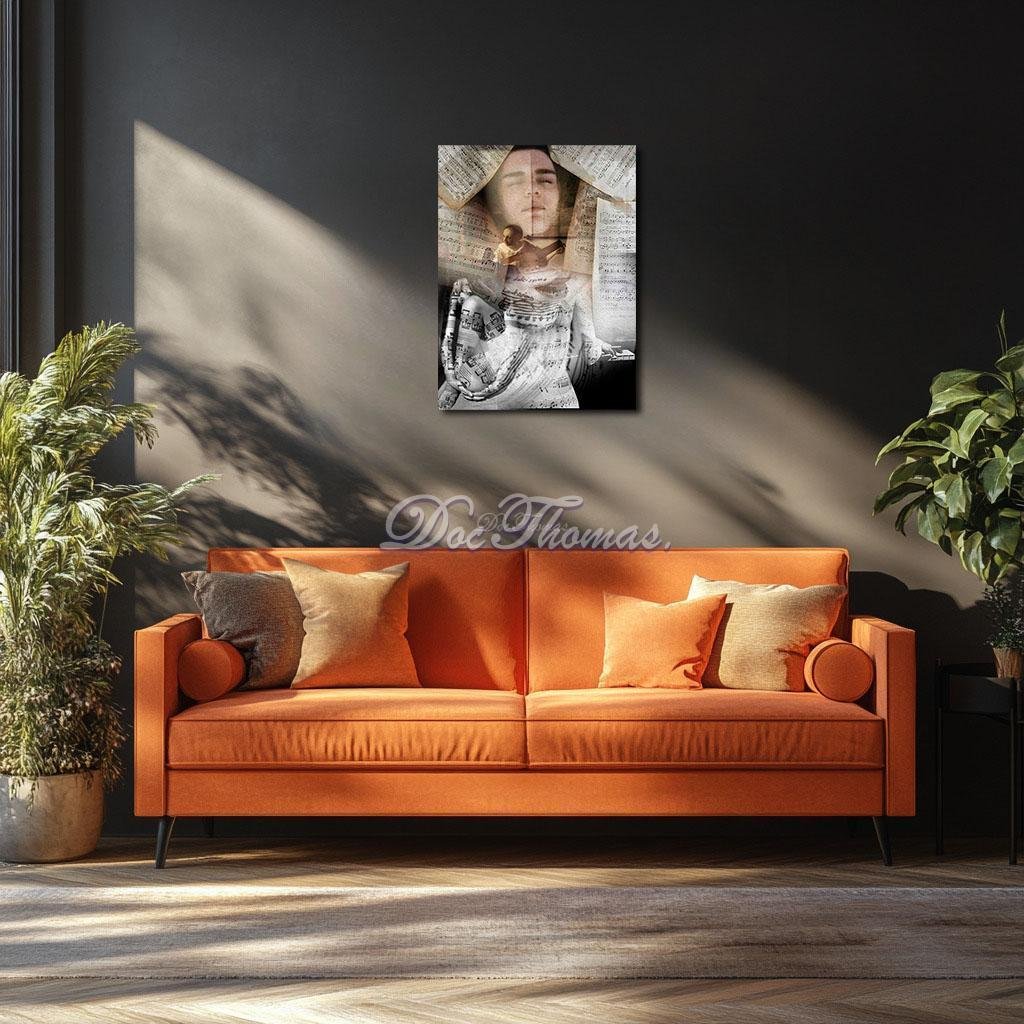Veins of Porcelain: A Fugue for the Absent Note
Veins of Porcelain: A Fugue for the Absent Note reimagines Vermeer’s Woman with a Lute as a layered elegy of music, longing, and identity. The woman is absorbed into a dreamscape of cascading sheet music and spectral forms, her figure merging with a young man whose skin is tattooed in notation. Pollock’s abstract gestures pulse through the fabric of memory and sound, while muted tones of sepia, grey, and ivory evoke a quiet interiority. Music becomes both clothing and confession, binding two souls across a silence never broken. This piece transforms Vermeer’s stillness into a silent symphony—where notes speak louder than touch, and melody becomes the face of what is never said.
Please see Below for Details…
Hotline Order:
Mon - Fri: 07AM - 06PM
404-872-4663
Veins of Porcelain: A Fugue for the Absent Note reinterprets Johannes Vermeer’s Woman with a Lute as a spectral meditation on longing, memory, and the invisible score of emotion. The lute, once held delicately in Vermeer’s quiet world of interior light, becomes an echo chamber for all the music left unsung—for love letters never sent, for sonatas trapped between breath and silence. In this reimagination, the painting dissolves into a layered symphony of musical notations, translucent faces, and interwoven selves.
The woman is no longer alone at a table but absorbed into the very architecture of sound. Her silhouette becomes one with a larger figure, a youth lost in reverie, eyes closed as sheet music pours from above like divine rain. Each page carries its own weight—worn with fingerprints, time-stains, and the invisible touch of lost composers. The music doesn’t just hover; it inhabits bodies. Notations become skin. A torso, a hand, a chest—all clothed in script and staff, each note a pulse, each rest a breath withheld.
The transformation is deeply symbolic. Vermeer’s lute becomes the key to a world where identity is no longer bound to the visual but to the auditory—where the body remembers more than it reveals. Her gaze, once contemplative and half-turned toward the window, now merges with the inwardness of a musician drifting inside a melody only they can hear. The presence of another—a man with his head tilted toward light, tattooed in staves—amplifies the yearning that defined Vermeer’s original. Here, he is both muse and mirror. Perhaps she dreamed him. Perhaps he is the song she never played.
Color guides the emotional terrain of this piece. Sepia and ash tones dominate, recalling old photographs, dusty libraries, the parchment of forgotten scores. The only hints of clarity come from the pearl-white gleam of music pages and the softened glow of her original face—still carrying Vermeer’s signature softness. There is no harsh contrast, only gradients of memory: smoky greys and faint lilacs, the palest blush of longing across the face of the silent player. Black, once solid, now bleeds softly into grey. The lack of vibrant color is not absence but intention. It speaks of an interior world where sound replaces hue, and emotion breathes not in saturation but in tonal pause.
As the artist, I imagined this as a duet of absence—two souls never touching, yet always in resonance. Vermeer’s lute player, though historically captured at the moment before song, becomes a symbol of the life not lived, the letter not delivered. I imagined that her music was never meant to be performed for an audience, but to awaken something inside—a memory, a lover, a version of herself that only existed in notes. So I surrounded her not with walls, but with layers—of staff lines, fragmented lyrics, and the ghostly presence of another. His face is peaceful, hers contemplative. Together, they exist in a room built from silence, their only architecture made of melodies.
Pollock’s influence echoes subtly in the abstraction layered throughout the background. His signature strokes are softened into almost vascular threads—less paint, more pulse. They emerge faintly in the fabric of the clothing, in the slight distortions behind the musical sheets, in the ghosted overlays that shimmer between the characters. His chaos becomes cadence, sublimated into the steady thrum of forgotten harmony. His lines here are not explosive but tethered, drawing invisible lines between the woman, the man, and the music that neither could fully hold.
This painting is a contemplation of connection. It is not about performance but presence—the type of emotional presence that lingers long after the music has ended. The scores that hang above the woman are not random—they are personal. Some are dissonant, others minor, some purely imagined. Each float like thoughts, poised just before being played or confessed. And her fingers, though distant from the strings, feel as if they’re still vibrating from the last note.
Veins of Porcelain: A Fugue for the Absent Note asks: what if music could become skin? What if each note held a version of ourselves we left behind? Vermeer’s original, steeped in restraint and introspection, offered a moment of musical delay. This reinterpretation draws that pause out into eternity—where melody is memory, where skin becomes sheet, and where love is not performed but felt in fugue and return.
Add your review
Your email address will not be published. Required fields are marked *
Please login to write review!
Looks like there are no reviews yet.










